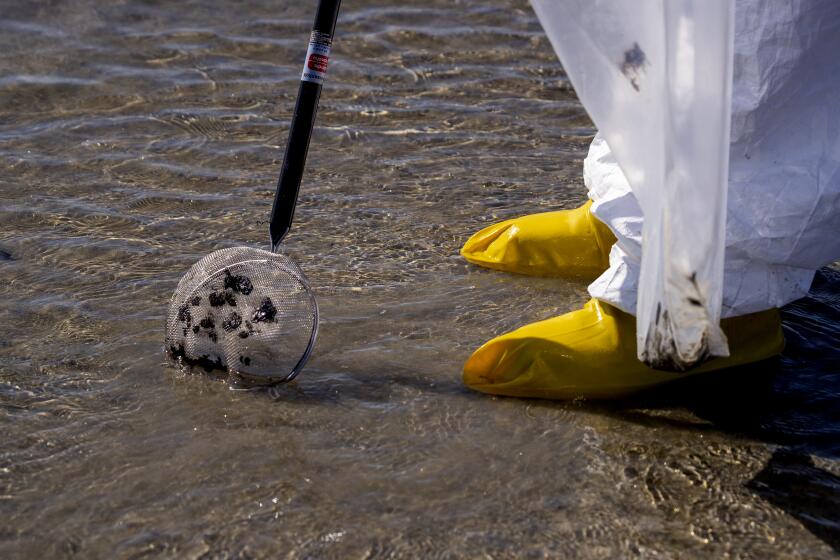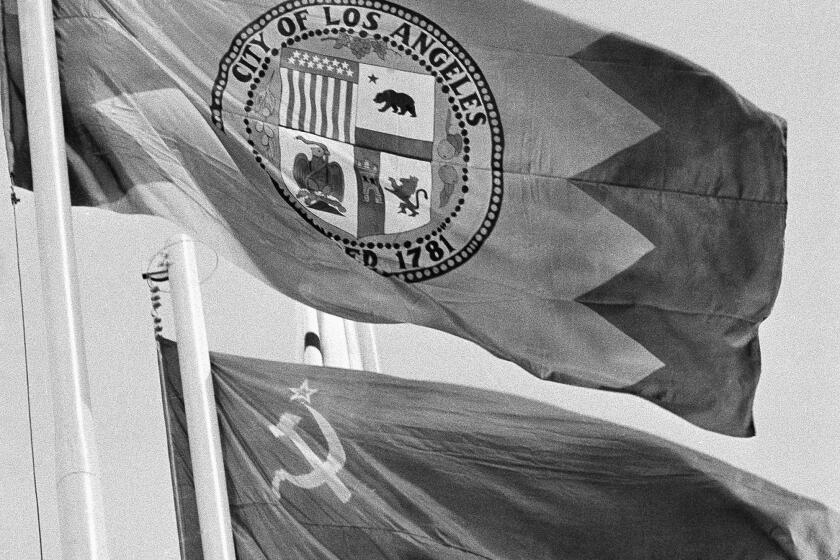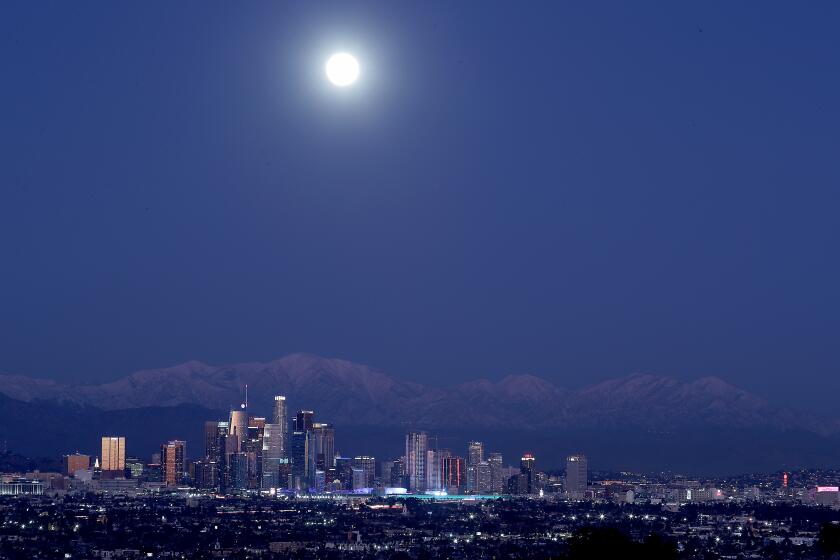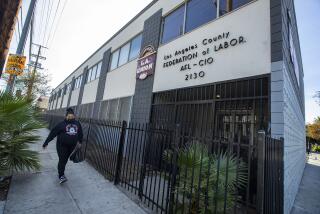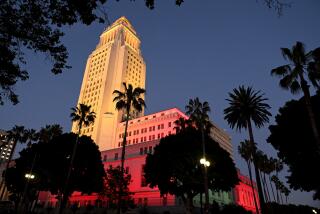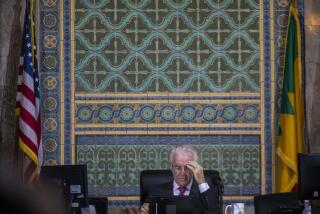In L.A., at least our corrupt officials don’t have much power
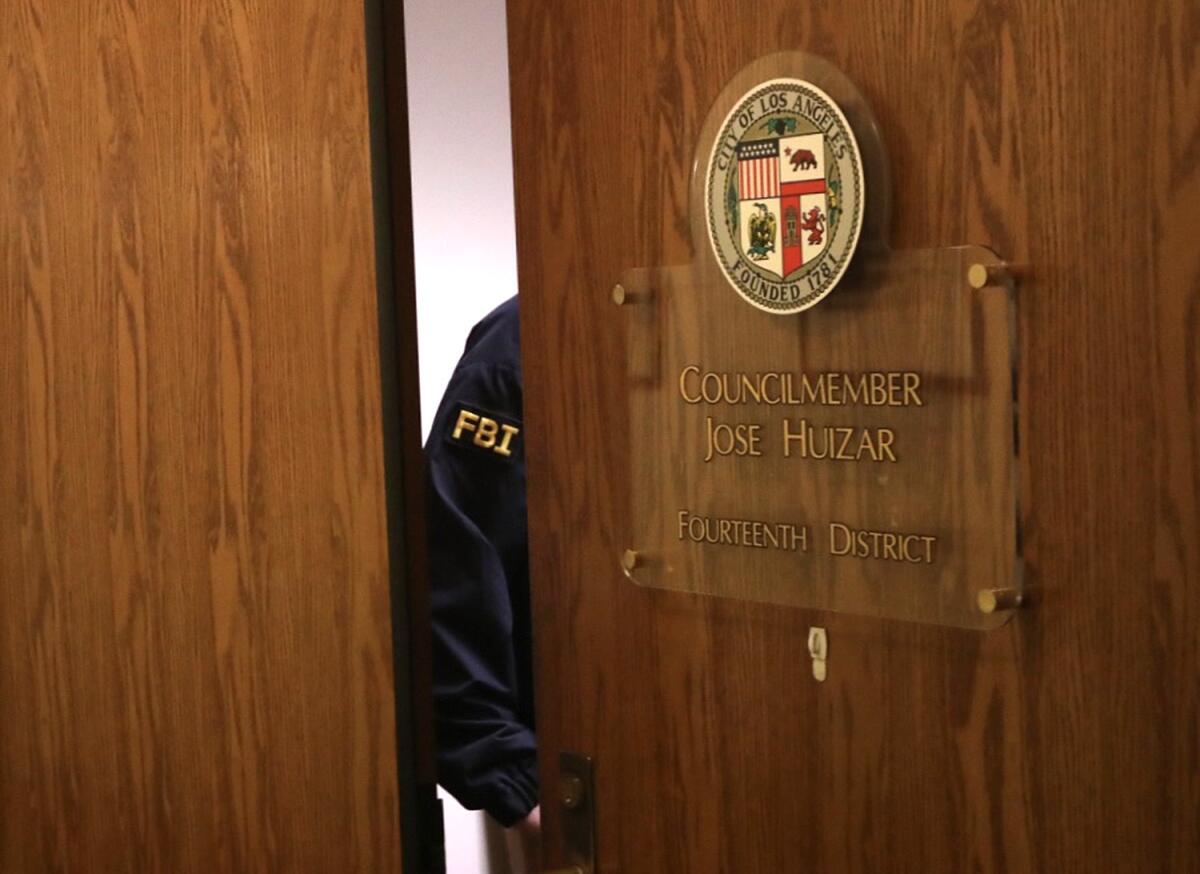
Well, at least we’re not Chicago, city of the big shoulders and bigger political pockets ready to be filled — Chicago, once again the most corrupt city in the nation.
Nor are we San Francisco, with its century-plus resume of public officials webbed in bribery, sex and nepotism scandals and even an instance of gun-running.
And Los Angeles can’t come close to the southeast L.A. County town of Bell, whose residents got the karmic satisfaction of seeing seven of their public officials hauled off to the pokey for rewarding themselves stupendously from the civic piggy bank.
But now Los Angeles — the city that for a dozen decades has preened itself as not being one of those roiling stews of East Coast big-city crooked pols — is seeing something a little different in its own mirror.
In the course of the FBI’s “Operation Casino Loyale” about pay-to-play real estate development schemes, ex-city council member Mitch Englander has gone to prison, pleading guilty to lying to the feds as they looked into gifts to Englander from a real estate businessman, among them the company of ladies of the evening. Ex-council member Jose Huizar is insisting on his blamelessness in a 41-count indictment against him over developers’ supposed down-low illicit money.
If that weren’t shock enough to the system on Spring Street, Councilman Mark Ridley-Thomas, a tent-pole figure in Los Angeles’ political life, was indicted on weighty federal counts from his county Board of Supervisors days, accused of swapping government contracts with USC in exchange for a scholarship and a sinecure for his son.
Explaining L.A. With Patt Morrison
Los Angeles is a complex place. In this weekly feature, Patt Morrison is explaining how it works, its history and its culture.
What you will see in all the stories about this, the accused being guiltless until proven otherwise, is a variant of the question that former Reagan labor secretary Ray Donovan asked the press when a federal corruption case against him went pffft: “Which office do I go to to get my reputation back?”
L.A.’s political scandals look pretty small potatoes compared to those other burgs. That may be in part because of how L.A. city government is designed: to spread out power and keep too much of it out of the hands of any one politician.
If, as the British pol Lord Acton said, “Power tends to corrupt, and absolute power corrupts absolutely,” there may be less temptation for an L.A. mayor because the job itself is less powerful. It’s not a weak-mayor system, as many of our mayors have griped, but it’s weak-ish-adjacent.
After the 1965 Watts riots, Connecticut Sen. Abe Ribicoff had occasion to quiz L.A. Mayor Sam Yorty on Yorty’s excuses about how limited his official powers are. “You have really waived authority and responsibility,” ticked off Ribicoff, “in the following areas of Los Angeles: schools, welfare, transportation, employment, health and housing, which leaves you the head of the city with basically a ceremonial function, police and recreation.” Yorty agreed, and helpfully added fire and sanitation to that list of his powers.
Most of those functions are not in the mayor’s hands at all, the way they are in New York or Chicago. The L.A. mayor crafts a city budget, picks commissioners and department heads, and can choose a police chief with the OK of the City Council and police commission. It’s a job that’s as much about influence and leadership as direct power.
And in L.A., City Hall candidates don’t run as political party members, as they do in New York. More than 100 years ago, reformers changed the election rules so that city office candidates are nonpartisan.
Southern California’s manufacturing helped win World War II. But the war effort and decades of polluting industry have left a toxic legacy.
If our City Hall scandals are not usually so brazenly corrupt as other cities’, it might not be for want of trying. But civic power is so flabby and diffuse that it’s hard to pull off a truly magnificent swindle (apart from the Owens Valley-L.A. aqueduct project, as much the handiwork of businessmen as politicians).
In 2015, as civic guru Rick Cole was departing his post as deputy mayor in L.A., he explained to me that “a lot of checks and balances are built into the system to avoid corruption and half-baked ideas, but … ironically, most were designed by reformers [who] were petrified of abuse of power. The charter was designed to prevent corruption, not to enable effectiveness. They took effective government for granted. So when you ask questions like, “Who’s responsible for the miserable state of L.A. streets?” you can blame anyone, because almost anybody has a piece of the problem and almost no one has the power to fix it. To avoid one problem, we so diffused power and hamstrung accountability, it’s no wonder we have the results we all complain about.”
What juiced up City Hall to make it work in spite of its operating manual? Not the pols, but the men who kept them on a short chain. Theirs was an aristocracy and oligarchy of powerful L.A. shot-callers — bankers, mercantile moguls, developers, publishers — who operated like a cabal for the first part of the 20th century and, after World War II, as the sub rosa Committee of 25. The committee saw to it that things they wanted done for and in L.A. got done.
This business group was so ruthless in protecting its powers that in the early 20th century, when some fellow businessmen created the Good Government Organization to reform city politics even slightly, the autocratic businessmen mocked these reform renegades in baby talk as “goo goos,” for “good government.” (Their mayoral candidate lost, but several City Council candidates won.)
As I read through city history, it struck me that scandalous and corrupt mayors have often been those who stepped out of line from the orthodoxies of the business moguls. The Times pulled pols’ strings for decades. In the 1960s, political reporter-fixer Kyle Palmer covered political events even as he manipulated them behind the scenes, and in the City Council chambers, The Times’ City Hall reporter, Carlton Williams, would walk past each member and, with a nod for yes and a head-shake for no, told them how The Times wanted them to vote on this or that matter.
(I am not delving into the LAPD’s corruption scandals here, but it’s inevitable that I will one day.)
So L.A.’s litany of elected politician scandals can begin with the charmingly named list of “most regrettable mayors” from the L.A. Almanac; its conclusions pretty much tally with mine.
Stephen C. Foster was mayor in the 1850s when a “vigilance committee” he belonged to, a kind of volunteer police force in crime-stricken L.A., tried to lynch an accused murderer. Foster held them off and promised to resign and lead the lynchers himself if justice failed. The killer was convicted, but when his execution was delayed, Foster kept his word: He quit as mayor, and led the lynchers to hang the man from a corral crossbeam. Voters put him right back in the mayor’s office.
Canadian-born Damien Marchesseault was mayor in the 1860s, when flood, drought, and pestilence (smallpox) plagued the fledgling L.A. He soldiered through all of that, but a few months out of office, with his $3,000 in gambling debts going dishonorably unpaid and the water system he was responsible for in collapse, he slipped into the empty City Council chambers and shot himself.
Mayor Arthur Harper’s early 20th century sins fell into more conventional corruption lines: avarice, cronyism, a prostitution syndicate in league with the police chief and a crime boss. A Times astrologer cast his horoscope in 1907 and predicted a future of “good fortune, personal advancement, wealth.” He resigned before a recall could take him out.
But the city kept those recall petitions warm.
The flashiest sex scandal was chalked up by mayor Charles E. Sebastian, who quit in 1916 after 15 months in office. He was a handsome devil, a former LAPD chief, and when his wife publicized letters he had written to his mistress calling the missus “the old haybag,” he resigned. For a time thereafter, he worked as a pump jockey at a gas station.
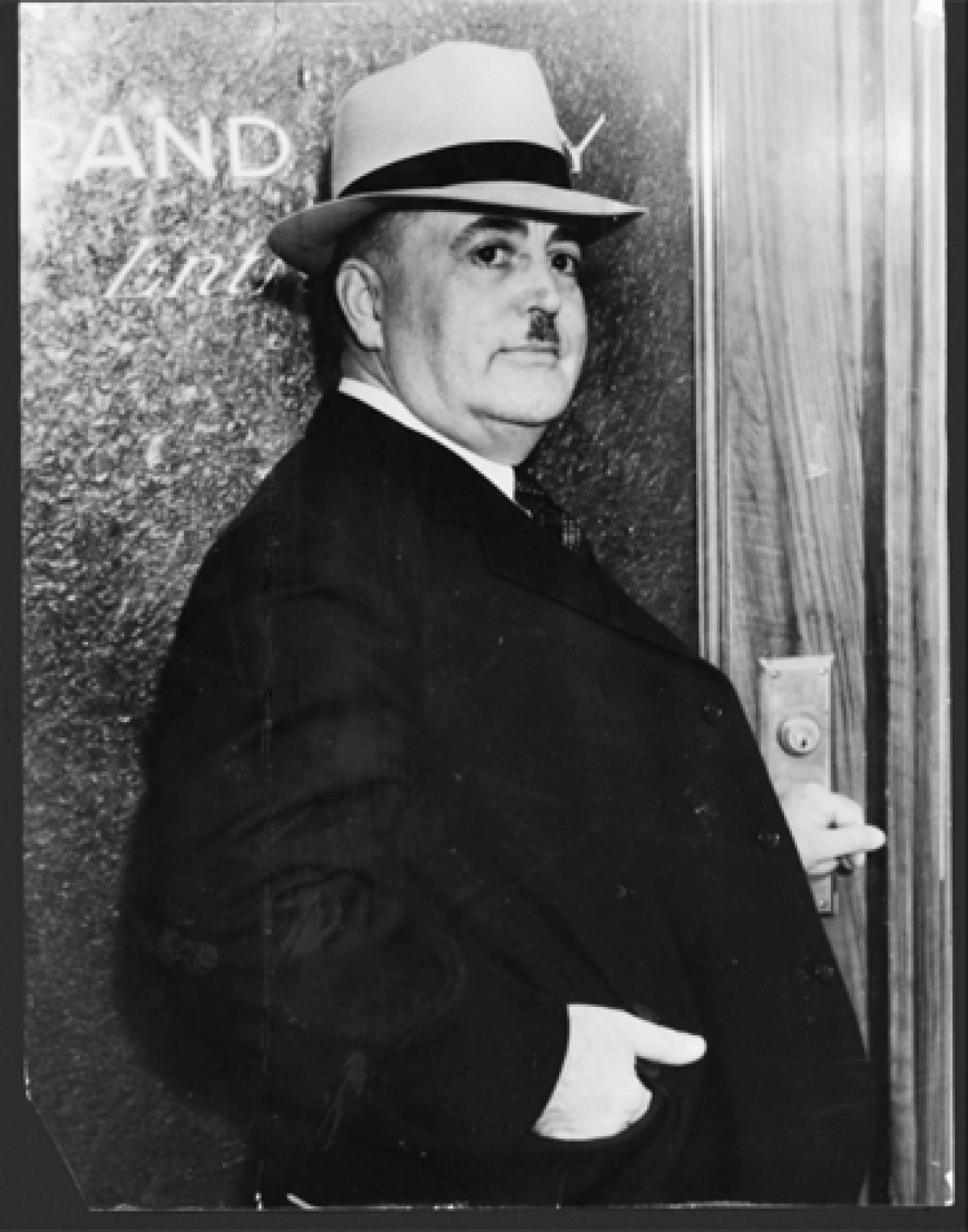
And the capper: Frank Shaw, mayor in the 1930s, our crookedest mayor, and the first big-city mayor ever recalled from office. He was accused of influence peddling of city jobs, including police positions, and winking at brothels and gambling dens. His ethical opposite, Clifford Clifton, was a cafeteria owner and crusader for good government. Clifton was evidently wiretapped by Shaw’s LAPD, and his house was bombed. Out came the recall petitions, and out went Shaw. Shaw’s brother, his right-hand man, was convicted along with Shaw’s civil service commissioner of selling government jobs, but the mayor himself was never charged.
City Hall’s elected officials have been less flamboyantly scandalous since then. In 1968, the City Council insisted on getting police reports on the 75 people that mayor Yorty was appointing to city commissions before it would approve them.
This was after four of Yorty’s harbor commissioners were convicted of varieties of corruption (two of those later reversed) and a fifth was found drowned in the harbor. Years later, when Yorty confronted fabled Times journalist and editor Bill Boyarsky about something he’d written, Boyarsky remembered that commissioner and his mysterious death. “Oh no, mayor,” Boyarsky said in a mock-pleading voice. “Not the harbor!” Yorty “gave me a look with those cold, cold eyes and I knew I had gone too far.”
Even the five-term mayor, Tom Bradley, all gravitas as L.A.’s first black mayor, was the subject of a federal political corruption investigation that went on for more than two years. The feds were said to be looking into whether Bradley had gotten insider trading tips from a brokerage firm while the city lobbied to keep that company’s junk bonds division in Southern California. It also wanted to know about Bradley’s connections with Far East National Bank, which paid him $18,000 a year for consulting, a year before the city deposited $2 million at the bank. The feds concluded that there was nothing to see here, move along.
Bradley aides and associates were found to be sometimes on thin ethical ice: At the same time Bradley collected $80,000 in campaign help from carnivals, he was intervening on behalf of one carnival businessman trying to buy city land. Bradley settled that violation for $55,000. For several years some of his aides ran a political fundraising network out of City Hall.
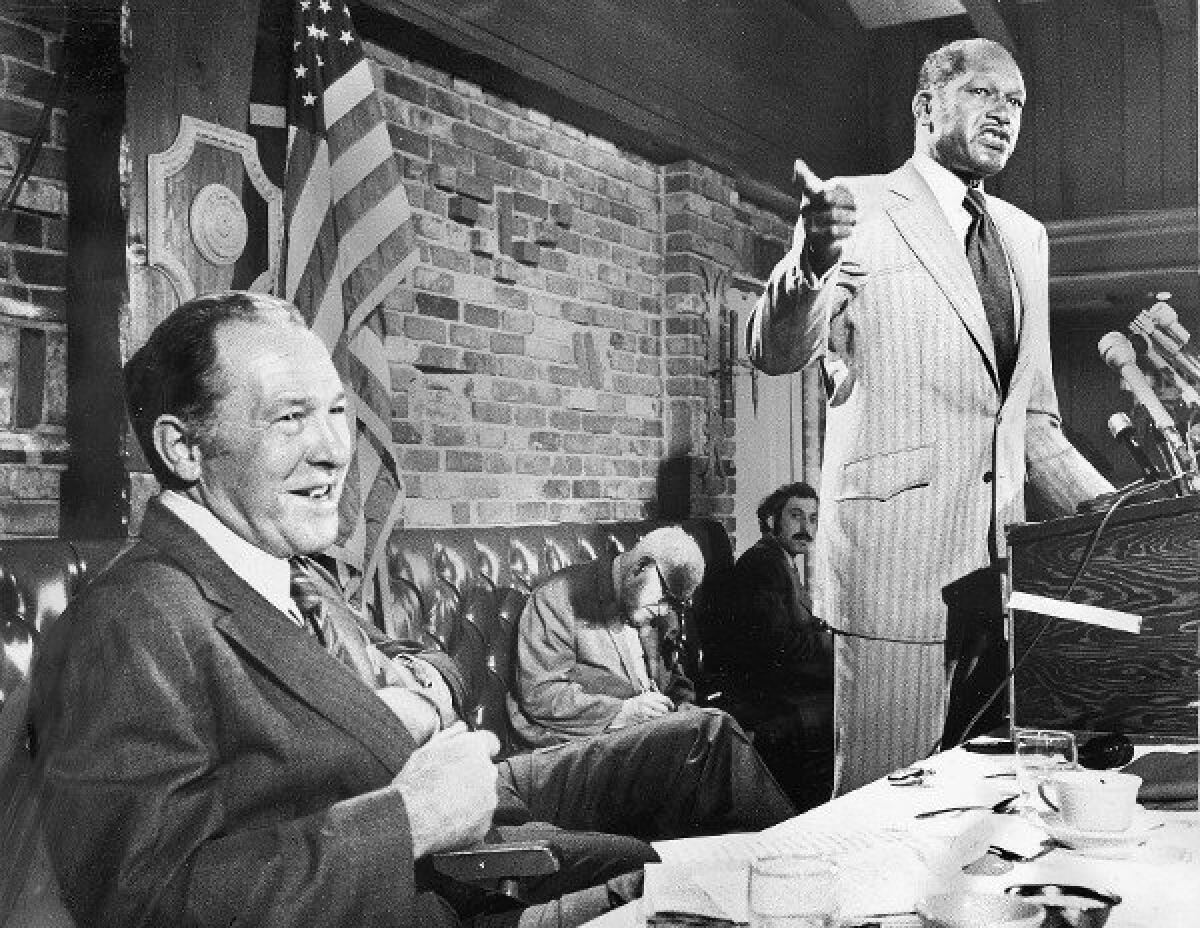
Now the 15 City Council members are immensely powerful in their own districts and often deferred to by other council members, who expect to get the same latitude in return.
Campaign violations have tripped up several of them. Voters may once have looked at those violations as business-as-usual for pols, but over time, the penalties have morphed from mere fines to slammer-time — and likelier to sway voters.
In the 1990s, councilman Richard Alatorre was sued rather than being criminally accused over shifting political money from one of his campaigns to another, and he and his campaigns ended up paying fines. Then in 2001, Alatorre — who chose not to run for reelection in 1999 — pleaded guilty to tax evasion and was sentenced to home detention and probation. The IRS, the FBI and the county’s transit authority inspector general had burrowed into the nature of more than $40,000 in cash that Alatorre had accepted as a councilman from people wanting his influence on their behalf.
In 2010, council member and former state Sen. Richard Alarcon was indicted for lying about where he actually lived — not in the district he represented. Four years later, he and his wife were found guilty of felony perjury and voter fraud. That was tossed out on appeal. The district attorney’s office said it would retry the case, but two years ago — nine years after the original indictment — the district attorney decided to let the matter drop.
Alatorre had taken over Art Snyder’s council seat. Snyder was the bad boy of City Hall, a red-haired, Spanish-speaking East L.A. Irish-German kid, whose attitude about many of his public transgressions seemed to be, “Yeah, so?”
Snyder was one of the earliest pols to run afoul of new campaign ethics and finance rules. He weathered an ugly divorce, and survived the headlines after eloping with a 19-year-old aide.
He totted up several accidents in city cars, and after one of them, he failed three field sobriety tests. His trial was one of the first to allow cameras and recording equipment in a courtroom. Before the trial, he thought it was a great idea, but after the jury hung 9-3 for conviction, he worried that cameras interfered with the right to a fair trial. He also believed the cops were out to get him. “The trial was conducted as if I were Charles Manson,” he complained.
The clubby bonhomie of the City Council, where the parameters of some conduct and even misconduct was rather elastic, was dissolved with new ethics rules, term limits, and televised meetings. Until about 2001, council members sat conducting the people’s business with their backs to the public.
Snyder resigned from the council in 1985 — Alatorre replaced him in a special election — but was soon back in court again, as a lobbyist accused of funneling contributions from relatives and colleagues to political campaigns. In 1999, he admitted his guilt in misdemeanor conspiracy and money laundering charges.
For much of its history, Los Angeles didn’t have a city flag. It does now, and it stands out for its sawtooth bands of bright color, one of which is supposed to represent orange crops.
City Hall’s most astonishing political comeback from scandal may be Mike Hernandez’s. An up-from-nowhere Northeast L.A. kid, he won election three times, but was a self-destructive mess — drinking tequila, snorting coke, smoking pot, watching porn in the office, sued as a financial deadbeat by a video rental store.
After he was arrested in Pacoima in 1997, with a bindle of coke he’d just bought, he thanked the cops for saving his life, posted bail, and checked into a rehab center, which spared him a drug felony record. He was not a universally welcome presence on the council thereafter, but his constituents sent him back to the job.
Three other recent-memory council members have gotten dinged for violating campaign finance rules. Over the course of a couple of elections, Nate Holden accumulated more than 70 campaign violations, and fines of more than $30,000 for them. Hal Bernson, a west San Fernando Valley councilman who’d had already been fined twice for campaign finance law violations, was fined again $18,500 in August 2001 for accepting donations above the city’s per-person contribution limits in his 1999 reelection campaign.
In 2011, then-mayor Antonio Villaraigosa and four city council members — including future mayor Eric Garcetti — were fined over the tickets they were given to attend awards shows like the Oscars and Grammys. In the 1980s and ‘90s, as the limits and rules on such freebies firmed up, mayors and council members have been called on the carpet for taking free trips, dinners, wine, and the like. (Let it be noted that some of these rules, and the paperwork they require, can be confounding.)
And Ridley-Thomas tripped over city rules on campaign spending rules. He and his campaign treasurer paid $10,000 in fines in 2001.
Paradoxically, one of L.A.’s best mayors, Fletcher Bowron, committed perhaps the worst offense. It wasn’t illegal, and at the time what he did was praised as patriotic.
Bowron was the mayor who cleaned up City Hall and the LAPD after the Shaw defilements, and presided over a modernizing, mid-century L.A. In 1949 he would make the cover of TIME magazine, in a good way; he is, the magazine wrote, “a fiercely honest man, and is eternally intent on protecting Los Angeles from itself.”
But after the Japanese attack on Pearl Harbor, he argued to move Japanese and Japanese Americans — “good and bad alike” — away from the California coast, suggested they could grow food to feed U.S. troops, and invoked the shade of Abraham Lincoln.
In a radio speech in February 1942, he said that “if Lincoln were alive today, what would he do … to defend the nation against the Japanese horde … the people born on American soil who have secret loyalty to the Japanese emperor? There isn’t a shadow of a doubt but that Lincoln … would make short work of rounding up the Japanese and putting them where they could do no harm.”
L.A. is a place like no other. You’ve got questions. Patt Morrison probably has answers and can definitely find out.
More to Read
Sign up for Essential California
The most important California stories and recommendations in your inbox every morning.
You may occasionally receive promotional content from the Los Angeles Times.

